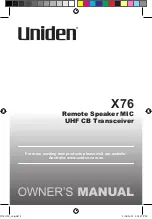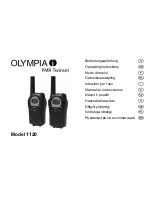
PT4208 Service Manual
13
an RF power attenuator and connected to a standard signal
generator (SSG)/frequency counter/deviation
meter/spectrum analyzer
!
Make sure no transmission operation is being conducted
while measuring the receiver!
During the adjustment/test/maintenance, make sure
reliable anti-static measures are taken for human body and
equipment.
6.1 Equipment and Software Required for Test and
Adjustment
Equipment and software listed in Table 6.1 are required
for test and adjustment of PT4208.
Table 6.1 Equipment and Software Required for Test and
Adjustment
No.
Name
Major Specifications
1 Computer
P2 or above, IBM compatible PC, WINDOWS
98/ME/2000/XP Operating System
2
Programming
software
KSP4208
3
Programming
cable
4 Clone
cable
KCL01
5
DC regulated
power supply
Output voltage:7.5V
Output current:
≥
5A
6 RF power meter
Measurement range: 0.5-10W
Frequency range: 100MHz-500MHz
Impedance: 50
Ω
SWR
≤
1.2
7
Frequency
counter
Frequency range: 0-1600MHz
Frequency accuracy: better than ±1×10
-6
Sensitivity: better than 100mV
8 Deviation
meter
Frequency range: DC600MHz
Measurement range: 0-±5kHz
9 DMM
Input impedance: above 10M
Ω
/V DC, capable of
measuring voltage, current and resistance.
10
Audio signal
generator
Frequency range:2-3000Hz
Output level: 1-500mV
11
RF power
attenuator
Attenuation: 40dB or 50dB
Supporting power : higher than10W
12
Standard signal
generator
Frequency range:10MHz-1000MHz
Output level: 0.1uV-32mV (-127dBm~-17dBm)
13 Oscilloscope
Frequency range: DC~20MHz
Test range: 10mV-20V
14
Audio frequency
voltmeter
Test range: 10mV-10V
Recommendation: Item 6, 7, 8, 10, 11, and 12 listed in
the table can be replaced by HP8920 general test set.
Figure 6.1 External Speaker/MIC Plug
6.2 Adjustment Items
After changing components during the maintenance, it is
necessary to test the radio and adjust its technical parameters.
The following part is going to introduce the adjustment
items.
Some parameters can be adjusted by use of KSP4208
programming software (in the Tuning Mode). The adjustable
parameters are as follows:
1) 6250Hz stability/2500Hz stability
2) Tx high power/low power
3) BATT Tx low voltage /Rx low voltage
4) SQL9/SQL1 On/Off
5)
QT DEV
6) DCS DEV
7) DTMF DEV
8) Rx sensitivity
Steps for adjustment:
a. Enter PC Test Mode. Refer to Chapter 4.
b. Click “Edit” in the main menu of KSP4208
programming software, and then click “Entry Tuning” in the
pull-down menu to enter the Tuning Mode.
c. Then the “Tuning Item List” screen will pop up.
Double click the item you want to adjust, and then you can
adjust the parameters.
d. Exit the PC Test Mode after adjustment.
6.3 Adjustment
6.3.1 VCO
Disable the “Battery Save” function, and set the Rx
frequency to the low frequency point (see Table 6.2). Under
the receiving status, measure the voltage of PD by DMM.
Then adjust the PD voltage to be 0.7V±0.3V by tuning the
trimming capacitor C180.
Set the Tx frequency to the high frequency point (see
Summary of Contents for PT4208
Page 1: ......
Page 35: ......
Page 36: ......
Page 39: ...PT4208 Service Manual 38 Figure 7 PT4208 Main Board Top Layer Layout 420 470MHz ...
Page 40: ...PT4208 Service Manual 39 Figure 8 PT4208 Main Board Bottom Layer Layout 420 470MHz ...
Page 46: ...PT4208 Service Manual 45 Figure 14 PT4208 Main Board Top Layer Layout 136 174MHz ...
Page 47: ...PT4208 Service Manual 46 Figure 15 PT4208 Main Board Bottom Layer Layout 136 174MHz ...
Page 48: ...PT4208 Service Manual 47 Figure 16 KBC 70C Schematic Circuit Diagram ...
Page 49: ...PT4208 Service Manual 48 Figure 17 KBC 70C Top Layer Position Value Diagram ...
Page 50: ...PT4208 Service Manual 49 Figure 18 KBC 70C Top Layer Position Mark Diagram ...
Page 51: ...PT4208 Service Manual 50 Figure 19 KBC 70C Bottom Layer Position Value Diagram ...
Page 52: ...PT4208 Service Manual 51 Figure 20 KBC 70C Bottom Layer Position Mark Diagram ...
Page 53: ...PT4208 Service Manual 52 Figure 21 KBC 70C Layout ...















































